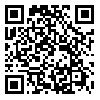دوره 6، شماره 3 - ( 5-1399 )
جلد 6 شماره 3 صفحات 174-163 |
برگشت به فهرست نسخه ها
Download citation:
BibTeX | RIS | EndNote | Medlars | ProCite | Reference Manager | RefWorks
Send citation to:



BibTeX | RIS | EndNote | Medlars | ProCite | Reference Manager | RefWorks
Send citation to:
Abolfathi A, Mehrabi F, Lotfi Sheikhani A, Mirzaei G R, Moslemi A, Sohrabi R. Demographic Characteristics, Clinical Symptoms, and Radiological Features in Patients With COVID-19 in Iran. JCCNC 2020; 6 (3) :163-174
URL: http://jccnc.iums.ac.ir/article-1-271-fa.html
URL: http://jccnc.iums.ac.ir/article-1-271-fa.html
Demographic Characteristics, Clinical Symptoms, and Radiological Features in Patients With COVID-19 in Iran. نشریه مراقبت پرستاری مددجو محور. 1399; 6 (3) :163-174
چکیده: (2838 مشاهده)
Background: Considering the new Coronavirus outbreak and limited data about this pandemic in Iran, this study aimed at assessing the demographic characteristics, clinical symptoms, paraclinical findings, and radiological features of hospitalized patients with COVID-19 according to their hospital records.
Methods: In this descriptive-cross-sectional study, the required data were collected from the Health Information System (HIS) and the records of the patients who had been hospitalized following positive COVID-19 Polymerase Chain Reaction (PCR) and lung Computed Tomography (CT) scans, in some hospitals of Markazi Province, Iran from February 20, 2020, to April 20, 2020. The selected hospitals were affiliated with the Iranian Social Security Organization. Clinical follow-up was continued until April 26, 2020. During this period, 260 records were assessed. The collected data included demographic characteristics, clinical symptoms, as well as the paraclinical findings and radiological features of the patients. The obtained data were analyzed by SPSS.
Results: Among 260 confirmed cases of COVID-19, 161 (61.9%) cases were men and 99 (38.1%) were women. The Mean±SD age of the explored patients was 58.78±16.44 years. Besides, 221 (85%) patients were hospitalized in the general ward and 39 (15%) cases in the Intensive Care Unit (ICU). Hypertension and diabetes were the most prevalent medical histories (comorbidities). Fever, fatigue, cough, anorexia, myalgia, dyspnea, oliguria, taste impairment, and smell deficiency were the most frequent clinical symptoms. Neutrophilia, lymphopenia, low blood glucose level, and increased BUN, ALP, CRP, and ESR were among the critical laboratory findings. Almost 30% of the studied patients presented acidosis in arterial blood gases analysis and 55% had normal blood gasses. Decreased PaO2 was observed in 80% of the investigated patients. Most of the patients had received oxygen therapy, lopinavir, and hydroxychloroquine. Additionally, 11.2% of the patients were under invasive mechanical ventilators. Concerning the lung CT scan, 42.7% of the patients had ≥5 involved lobes. In terms of density, 51.9% of the subjects had mixed opacity. Most lung damages (41.5%) were in the central part of the lungs. In 55.8% of cases, these damages were patchy lesions, and 40% had an air-bronchogram. According to the Chi-squared test data, there was a significant relationship between the location of the lesions and the patient’s need for suction (P<0.001). Besides, patients with central lung lesions required the highest percentage of suction (26%). In this study, 15% of the explored patients were hospitalized in the ICU, 84% were discharged by April 26, and 8.07% died.
Conclusion: The current research results provide the health team with beneficial information about the assessment and care of patients with COVID-19 and the prediction of treatment outcomes.
Methods: In this descriptive-cross-sectional study, the required data were collected from the Health Information System (HIS) and the records of the patients who had been hospitalized following positive COVID-19 Polymerase Chain Reaction (PCR) and lung Computed Tomography (CT) scans, in some hospitals of Markazi Province, Iran from February 20, 2020, to April 20, 2020. The selected hospitals were affiliated with the Iranian Social Security Organization. Clinical follow-up was continued until April 26, 2020. During this period, 260 records were assessed. The collected data included demographic characteristics, clinical symptoms, as well as the paraclinical findings and radiological features of the patients. The obtained data were analyzed by SPSS.
Results: Among 260 confirmed cases of COVID-19, 161 (61.9%) cases were men and 99 (38.1%) were women. The Mean±SD age of the explored patients was 58.78±16.44 years. Besides, 221 (85%) patients were hospitalized in the general ward and 39 (15%) cases in the Intensive Care Unit (ICU). Hypertension and diabetes were the most prevalent medical histories (comorbidities). Fever, fatigue, cough, anorexia, myalgia, dyspnea, oliguria, taste impairment, and smell deficiency were the most frequent clinical symptoms. Neutrophilia, lymphopenia, low blood glucose level, and increased BUN, ALP, CRP, and ESR were among the critical laboratory findings. Almost 30% of the studied patients presented acidosis in arterial blood gases analysis and 55% had normal blood gasses. Decreased PaO2 was observed in 80% of the investigated patients. Most of the patients had received oxygen therapy, lopinavir, and hydroxychloroquine. Additionally, 11.2% of the patients were under invasive mechanical ventilators. Concerning the lung CT scan, 42.7% of the patients had ≥5 involved lobes. In terms of density, 51.9% of the subjects had mixed opacity. Most lung damages (41.5%) were in the central part of the lungs. In 55.8% of cases, these damages were patchy lesions, and 40% had an air-bronchogram. According to the Chi-squared test data, there was a significant relationship between the location of the lesions and the patient’s need for suction (P<0.001). Besides, patients with central lung lesions required the highest percentage of suction (26%). In this study, 15% of the explored patients were hospitalized in the ICU, 84% were discharged by April 26, and 8.07% died.
Conclusion: The current research results provide the health team with beneficial information about the assessment and care of patients with COVID-19 and the prediction of treatment outcomes.
| بازنشر اطلاعات | |
 |
این مقاله تحت شرایط Creative Commons Attribution-NonCommercial 4.0 International License قابل بازنشر است. |





